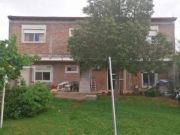The circuit of the south bank of Negro River See map
So far, the north-Patagonian area had been widely disseminated at the torurism level. A tour of area of farms of the Upper Valley on the north bank of Negro River, is one of the options for sightseeing in the area. But in recent years, the Endemas (Development of the South Bank Entity) is promoting the south bank circuit.
This area comprises 500,000 hectares semi-desert, located south of the Negro and Limay rivers. The territory is part of the city of Cipolletti (Río Negro Province). It's a city that is located in the area of "Upper Valley", whose main production are apples and pears, as well as wine, cider, juice and champagne.
The "Tourist Corridor of the South Bank" is mostly a rural landscape, natural and very fully competitive from the ecological, because the territory has little or no anthropogenic changes.
The environmental characteristics of landscapes, paleontological remains and cave paintings in the Patagonian plateau pose promoting low-impact activities of knowledge (ecotourism), observation, education, camping, fishing, scientific activities, hiking, biking, and more.
The conservative tourist profile is consistent with the comprehensive development of the region from the design of protected area of production without polluting or differentiated, so that strengthens the brand name "Patagonia" as recognized in the market.
Features
The Tourist Corridor is along Provincial Route No. 7 as the backbone of the different tourist areas, with three optional circuits with landscapes totally different and contrasting, such as semi-arid plains and oases fluvial-lacustrine (of the rivers Limay, Negro and lakes Arroyito and Ezequiel Ramos Mexia). The corridor connects eight areas with different attractions: Cipolletti, Confluencia (of rivers Limay and Neuquen forming the Negro), Las Perlas, Anfiteatro, Arroyito, El Chocón, Lonca Vaca and Limay Medio-Naupa Huen.
Main Attractions
80% of the territory is protected area "Cretaceous Valley" (Law 3033 Province of Río Negro), created for the preservation of paleontological resources and landscape. The native fauna of the steppe-mountain is attractive such as rheas, maras, guanacos, partridges and abundant water wildlife as silversides and salmonids (introduced trout) in the Limay River system.
Lakes Arroyito - Chocón have interesting coastal cliffs over 60 meters high, with bays very suitable for large marinas and sandy beaches and relief witnessed of high scenic value, plus the abundant dinosaur traces. They are also an area of high bio-diversity of plants and fauna given by the coexistence of riparian species (willow, wicker, poplar) and upland species originally adapted as creosote bush, alpataco, chañar, tamarisk and other.
On the plateau (Anfiteatro, El Chocón) are impressive canyons up to 60 meters deep, that reveal layers and layers of different colors, with many paleontological fossils represented by fields of petrified logs, bones of dinosaurs and other prehistoric animals. Some of them over 100 million years old.
The different layers are differentiated by color. There are sand, silt and clay red corresponding to the Upper Cretaceous period, others more yellow of lacustrine origin with remains of freshwater fish and, above them, light-brown and dark sandstone and belonging to the Upper Cretaceous period, environment where the petrified logs appeard, product of a process of silicified.
As a cultural attraction distinguishes the paintings of Lonco Vaca (in Mapuche language "cow head"). It is a landscape of plains and hills intersected by ravines, with significant outcrops of granite rocks that rise to small watersheds, very important to the region by raising cattle, sheep and llamas. The landscape is full of history to find traces of former inhabitants who left their paintings on granite walls.
The area of Limay Medio- Naupa Huen is a section of the Limay River in a landscape of contrasting vegetation: a mixture of riverine forest of willow wicker-colored with a vegetation of mountain. This stretch of the river include large populations of native species such as largemouth bass and smallmouth, Patagonian silverside, catfish of torrents and "madrecita del agua", as well as brown trout and rainbow trout, two prized salmon for sport fishing because of the size and vigor they achieve.
Services
The city has an important infrastructure with accommodation, dining, shopping and transport (bus terminal, National Route No. 22 and 12 km from International Airport of the city of Neuquén).
Its geographic location is linked to different cities of the Upper Valley of Río Negro and Neuquén like Neuquén Capital, Allen, General Roca, Villa Regina, area approximately 450,000 inhabitants which has a facility of 3,000 hotel beds.
Endemas
Endemas is an entity created to develop the south bank of the rivers Limay and Neuquen, its main objective is the planning, promotion and coordination of studies for the sustainable development of the South Bank - Cipolletti in Río Negro. We define "sustainability" the task to value the land, to enable agricultural and livestock production, mining, tourism, recreation and others with a conservative use. This contributes in some way to a more equitable society, ensuring a better quality of life for all inhabitants and visitors.
Alojamiento en Cipolletti
 Departamento Departamento Carolina
El Departamento Carolina se encuentra en Cipolletti y ofrece alojamiento con aire acondicionado y acceso a un jardín.
Todosver másTel: Cipolletti
Departamento Departamento Carolina
El Departamento Carolina se encuentra en Cipolletti y ofrece alojamiento con aire acondicionado y acceso a un jardín.
Todosver másTel: CipollettiViajes por la Patagonia
Related Articles
© Patagonia.com.ar 2026 | Todos los derechos reservados.
